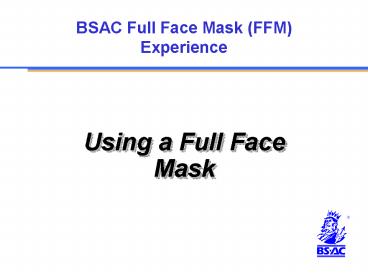BSAC Full Face Mask FFM Experience - PowerPoint PPT Presentation
1 / 15
Title:
BSAC Full Face Mask FFM Experience
Description:
Rota system. Be ready in shallows. BSAC FFM Experience. FFM.2. 06/07. Aims. What is a Full Face Mask? ... A full face mask (FFM) encloses the whole face. Eyes, ... – PowerPoint PPT presentation
Number of Views:194
Avg rating:3.0/5.0
Title: BSAC Full Face Mask FFM Experience
1
BSAC Full Face Mask (FFM) Experience
Using a Full Face Mask
2
FFM Experience outline
- Theory Workshop
- Advantages of a FFM
- Fitting a FFM
- Precautions to be taken
- Dry workshop
- Practice fitting and removal
- Pool session
- Work in pairs (usually)
- 1 mask per pair
- Rota system
- Be ready in shallows
3
Aims
- What is a Full Face Mask?
- Why use a Full Face Mask?
- Using a Full Face Mask
- Precautions
4
What is a FFM?
- A full face mask (FFM) encloses the whole face
- Eyes, nose and mouth!
- Most FFMs are divided into two halves
- A mask
- provides an air space for the eyes
- An oro-nasal pocket
- allows you to breathe through mouth or nose
- reduces the dead space volume
- prevents build up of carbon dioxide
5
Why use a FFM?
- Allows natural nose and mouth breathing
- Less stress
- Communications
- Diver to Diver e.g. for monitoring
- Diver to Surface e.g. aids project work
- Insulation from cold or polluted water
- Breathing supply secured through mask
- Less jaw ache on long dives
- Gas supplied in event of blackout
6
Parts of a Full Face Mask
Face plate
- Regulator
7
Parts of a Full Face Mask
Nose block
- Skirt
Spider
8
Fitting a FFM
- Correct fitting and adjustment key to
- Comfort
- Preventing leaks
- Demist using antifogging agent.
- The cup of the spider should be positioned so it
sits at the back of the head, below the crown.
Correct
Incorrect
9
Fitting a FFM
- Normally accomplished by tightening the bottom
straps first.
then working the way up.
PRACTICE before use.
10
Releasing a FFM
- Most masks have quick release buckles on lower
straps. - Pull mask up and away from face, use thumbs to
release straps.
PRACTICE before use.
11
Dry Workshop
- Practice Session
- Work in pairs
- Ensure air is on or regulator is removed!
12
Precautions
- Mask malfunction
- Practice clearing a flooded mask
- Carry spare half (normal) mask and AS
- Alternative Supply
- In case own mask floods
- For buddy - sharing FFM not practical
- Carbon dioxide build-up
- Caused by poorly fitted/vented mask
- Hypercapnia
- Increased air consumption
13
Hints and tips
- Take time to ensure a good fit
- Practice fitting and releasing until competent
- Check for leaks in shallows
- Equalisation method depends on mask
- Pinch nose as normal (Scubapro) OR
- Push whole mask against face until nose block
blocks nose!
14
Summary
- Why use a Full Face Mask?
- Parts of a Full Face Mask
- Fitting a Full Face Mask
- Releasing a Full Face Mask
- Precautions
15
(No Transcript)































